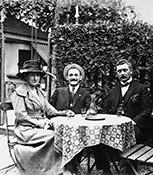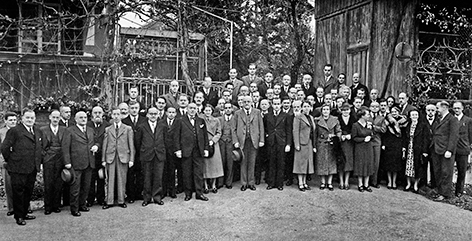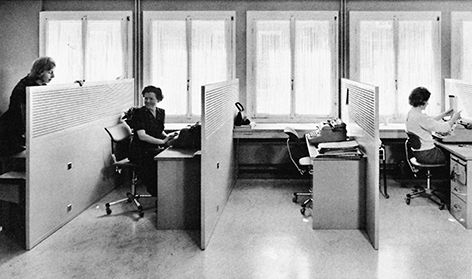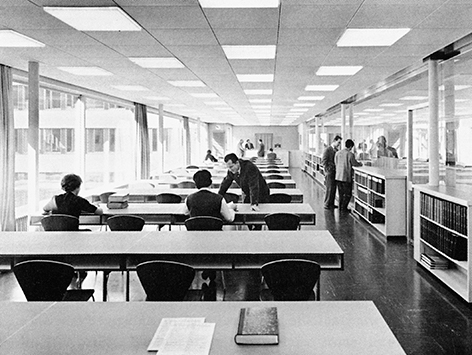For IP professionals
This is the portal for professionals working in the field of intellectual property. Here you'll find direct access to all necessary resources.
Quick links
The history of the IPI
The history of the IPI is an eventful one. It has been the federal government’s central point of contact for all questions concerning patents, trade marks, geographical indications of source, design protection and copyright since 1888. Not only has it evolved continuously, it is also particularly proud of one of its past employees who is famous across the entire world.
The then Federal Industrial Property Agency officially came into existence on 15 November 1888. This was as a result of the Patents Act of 29 June 1888 and the Industrial Designs and Models Act of 21 December 1888. These two new laws required a new federal office to assume the associated tasks.
The Federal Intellectual Property Agency existed for 90 years before being renamed the Federal Office of Intellectual Property in 1978 under the new administrative organisation law. Finally, on 1 January 1996, it was granted operational independence. Since then, it has been called the Swiss Federal Institute of Intellectual Property (IPI).
From seven to around 300 employees
The number of patent applications for inventions have increased steadily over the years, as have applications for trade mark and design registrations. These increases are also reflected in the expansion of the IPI workforce. Where there were only seven people working at the federal office when it was founded in 1888, the number of staff grew to 76 employees in 1937 and 191 in 1963. Today, the IPI employs around 300 members of staff. The reasons for this growth are due to a rise in the IPI's core tasks, its taking on new responsibilities and, above all, the expansion of various services.
The IPI is responsible for creating the necessary legal frameworks for protecting intellectual property. This applies, in particular, to trade marks, patents, designs and copyright. In addition, the IPI has the task of actively representing the interests of Switzerland in international organisations. This means that the IPI is the primary contact for industrial property rights as well as being the federal government’s "law office" for intellectual property.
Providing policy services has gained in importance in recent years. It entails advising the political authorities, preparing legislation and representing Switzerland at international level.
The provision of training courses and search services has gained in importance, too. Such services provided by the IPI help to increase the opportunities for individuals and businesses to use the intellectual property protection system for their own economic success.
The IPI also has a mandate to provide information. This includes providing balanced information on the various national and international systems for protecting IP rights, how they function and how to use them. It must do all of this in a user-friendly way.
The IPI's most famous employee ever
Albert Einstein, who formulated the theory of relativity, started working in the patent division of the office in July 1902 as a "technical expert – class III". At his standing desk in room 86 in the office’s premises on the corner of Speichergasse and Genfergasse in Bern, a young man examined inventions for their patentability. These most likely included a machine for sorting gravel, a weather station that was influenced by humidity of the air, and an electric typewriter with shuttle-type carrier.
For Einstein, the patent office was "that worldly cloister where I hatched my most beautiful ideas". This is where he experienced his most creative period to do with physics. In 1905 alone – in what is known as his annus mirabillis – the then 26-year-old published five works that turned the dominant world view of physics on its head. To the regret of his superiors, Einstein left the office in the autumn of 1909 to take over the chair for theoretical physics at the University of Zurich.
From tenant to property owner
During its history, the IPI hasn't only changed its name and formal integration into the federal administration. It has also changed its location many times within the city of Bern. The office first moved from the former Institute for the Blind in the Lorraine quarter (1888 to 1893) to Bern city centre. From there, it moved from the federal telegraph building on Speichergasse (1893 to 1907) into the old post office building at "äussere Bollwek" (1907 to 1921).
After a good ten years in office barracks in the Spitalacker area of the city, the office then moved into the Swiss National Library building in the Kirchenfeld quarter in 1931. In 1960, the office then moved in the vicinity to the former Eschmannstrasse (today Einsteinstrasse). In June 2007, the IPI moved location for the last time and settled down in the northern district of the city at Stauffacherstrasse 65. Due to the IPI's financial autonomy and business going exceptionally well at that time, the IPI was able to finance the new building entirely from its own funds and to move, as a property owner, from the tranquil embassy quarter of the city to Bern's main business development site.
Open-minded from the outset
When protecting intellectual property, it is too short-sighted to think of doing so from a purely national perspective. This was a realisation that became apparent very early on. Already in 1883, Switzerland was playing a significant role in an agreement between several countries on intellectual property. On 20 March 1883, it put its signature and seal to the Paris Convention. This is still the most important international treaty for the protection of industrial property today.
The IPI's current international development collaborations are based on the same considerations as back then. Within its field of responsibility, the IPI works together with selected countries to help them build up a functioning system of IP protection. The goal of such collaborations is to adequately protect investment and sales markets abroad.
The IPI pursues various projects concerning the protection of intellectual property and the economic situation in the partner countries. In the past, it has helped Jamaica and Kenya to help build up a national system of protection for local geographical indications of source.
It has also supported the local authorities in Vietnam in building up a national database of traditional Vietnamese medicines. Current IPI partner countries are Indonesia, Columbia, Ghana, Serbia and Laos. The projects with these countries are financed by the Swiss Federal Institute of Intellectual Property (SECO).
The IPI as an e-government pioneer
The IPI is one of the pioneers of e-government in Switzerland. As early as 1984, it had introduced the Technical Information Service for Patents (TIPAT) for online searches. The aim was to make the huge amount of technical information created by users of the patent system available to a broad range of interested stakeholders via modern means. This service clearly met a great need as it was very popular.
TIPAT continued to develop in the following years and more and more patent examiners were being used to carry out patent searches. The services governed by private law were also anchored in the IPI Act in 1996 when the Federal Office of Intellectual was converted into the autonomous Swiss Federal Institute of Intellectual Property. Since 2004, the IPI has been selling these customised patent, technology and trade mark searches in almost every country of the world under the service label ip-search.
Since 2001, potential applicants for IP rights have been able to retrieve information from the trade mark, patent and design registers free of charge and within seconds thanks to the online register Swissreg. Since 2008, the platform has also been used as the official publication for industrial property rights and replaces all printed organs of publication. The information is available barrier-free and is therefore also accessible without restriction to people with disabilities.
Transparency as our hallmark
It has been possible to file an electronic trade mark application via e-trademark since 2002. This means that even customers without their own trade mark database and specific interface can enter and submit their Swiss trade marks online.
The IPI has also been providing a new online examination support tool on its website since July 2013. This IPI database contains 500 entries that contain not only abstract examination rules, but also decisions on applications for trade mark registrations made by the IPI. Like the classification tool, this tool also helps to predict decisions on trade mark applications. It represents a further step in the IPI's strategy to ensure the widest possible transparency with regard to its practice.
Since mid-2010, customers can send their official submissions in a timely and legally-binding manner by email. On 1 July 2011, the IPI also introduced electronic communication for opposition proceedings. Since its introduction, this service has been very popular. The percentage of applications registered via email has been at 95% for a number of years – and the trend is rising.
Always at the cutting edge of development
The IPI already provides its customers with substantial possibilities for communicating electronically. In the future, users will have additional channels for communicating directly with the IPI. This is why the renewal and expansion of the IP rights administration system is currently a core project of the IPI.
It is its economic autonomy that makes it possible for the IPI to work in an agile way, which in turn leads to ongoing innovation. And it does this by continually taking into account an increasingly global and changing environment. The IPI's strength lies in the constant review and development of the IP rights administration system. In this capacity, the IPI has been making a significant contribution to the economy.
Looking back at several milestones in the history of the IPI
The first female employee
In the first three decades following its founding, the office employed only male members of staff. In 1918, the Department of Justice and Police granted the Federal Intellectual Property Agency permission to “employ two to three female clerks, to whom the care of the typewriter work should be entrusted”. Emma Müller successfully applied and was the first woman to work as an office clerk at the office from 1918 to 1930.
The first company outing
Take dictation, please
Back in 1963, patent examiners dialled a special phone number and dictated their patent examination reports onto tape. The secretaries then typed up the dictation and handed over the required number of copies of the finalised examination reports to the internal mail. These reports landed on the examiner’s desk a few days later ready to be dispatched.
Patents in cardboard boxes and in jukeboxes
By the mid-1970s, the IPI had one of the most well-known patent collections in Europe. The archives of the extensive Central Patent Collection took up three basement floors in the Einsteinstrasse building. The documents were kept in thousands of boxes which, if laid end to end, would have spanned several kilometres. There was also a reading room available where people could inspect and study the documents at their leisure. It was a small revolution when data became digitalised and began to be stored on CD-ROMs. The patent collection then became available electronically at multiple locations (such as the ETH Zurich) in what were called “jukeboxes”. With these, it was possible to enter a search term and the correct CD was then automatically retrieved.
Chess without checks
Only during the Age of Enlightenment did the growing self-assurance of artists and the growing awareness of society begin awakening to the fact that artistic works deserved protection. This resulted in the doctrine of intellectual property being born: people who create intellectual works should – like craftsmen – have a right of ownership to the results of their work. At the beginning of the 19th century, countries such as England, France and Prussia created national regulations for dealing with intellectual property. In 1883, the first Copyright Act was passed here in Switzerland. As with the Paris Convention (also of 1883), which provides protection for patents, trade marks, industrial designs, utility models and trade names, Switzerland was also one of the founding members of the Berne Convention in 1886. This convention protects works of literature and art. On 11 September 1986, the 100-year anniversary of the Berne Convention for the Protection of Literary and Artistic Works on, Federal Councillor Elisabeth Kopp unveiled a sculpture by Heinz Brand entitled: “Schachloses Schach” (chess without checks). The sculpture, which is a chess board standing on its edge with two squares missing, stands in front of the Federal Archives in the Kirchenfeld quarter of Bern.
The IPI celebrates its 125th anniversary at Loeb
The IPI decided to make an appearance at a very prominent public location to mark its 125th anniversary. Inspired by the motto “Envisioned. Created. Protected.”, it presented the topic of intellectual property from the end of May until mid-June of 2013 in the display windows of Loeb, Bern's long-standing traditional department store. With a wall of light, a trade mark show and a giant potato, passers-by learned how patents affect our lives, how brands create identity and trust, and why design is a positive selling point. The window display also gave information on how the IPI became a pioneer of the federal government and how inspiring Albert Einstein found his work as a patent expert at the office. By linking to the department store’s product world, it was clearly demonstrated how intellectual property is an integral part of our daily lives.






